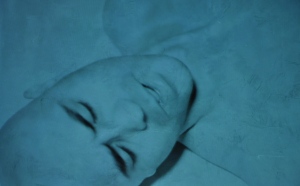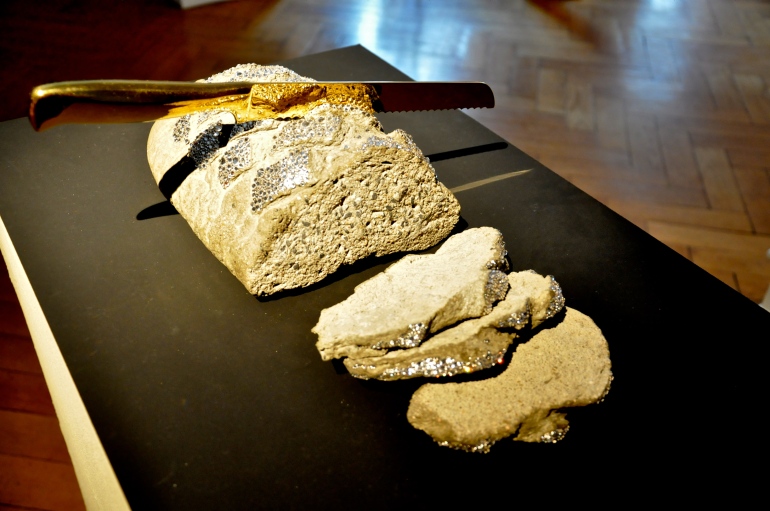Vanitas is the first exhibition curated and organised by Isabel Bernheimer Contemporary at the Gallery Bernheimer in the heart of Munich. It challenges the discourse on historically well-preserved still lifes – focusing on the connection between life and death, aesthetics and disgust – and contemporary art practice.
Surrounded by art from the seventeenth century onwards, the latest works of the Berlin-based artists Victor Alaluf and Jan Kuck represent two different ways of creating art. Instead of reviving well-known themes of still lifes, such as flowers, skulls, ceramics and dead animals, the two befriended artists have created an allegorical nexus around the conservative subject of Vanitas by linking human nature to art.

Even though the two artists work next door to each other in Berlin, their work could not be more different. While the Argentine artist Victor Alaluf focuses on the interaction between human science and art, Kuck’s work is a visual reinterpretation of philosophical theories by Plato and Kant. For example, the three-pillar installation Noumenon (greek “something that is thought”) by Kuck is based on Plato’s allegory of the cave. Made from timber, a polystyrene pediment coated with a layer of three-centimeter thick concrete, the Noumenon creates reality and illusion through illumination; but what is considered to be real, is not always true. At the opening of the exhibition Konrad Bernheimer Senior, the owner of Bernheimer Old Masters in Munich and Colgnaghi in London, pointed out that the illuminated columns project the immanent question of what is real onto the ceiling of his gallery space. Hence, Noumenon is a visual representation of a materialistic friction between Husserl’s phenomenology and Kant’s transcendental philosophy, which is further reinforced by the mindful play with bright and dark light in the second room of the exhibition.

Alaluf’s art, on the other hand, addresses the sensation of the viewer’s human body. Using vertebras and blood vessels made from gypsum and other organic media, he draws a link between one’s own flesh and its architectural interior. Hence, this alignment between art and human science makes an interesting mélange between the mortal human body and art without a date of expiry; and at the same time, this juxtaposition points out why still lives are also named Natura Morte or Memento Mori.
While Kuck’s artistic concept is based on widespread humanistic theories, which are difficult to refute due to the complexity of verifying them, Alaluf’s art is based on the composition of the inner human body. In particular, he is interested in the bony scaffold underneath the human skin. The human skeleton, single vertebras, blood vessels, wounds and blood are only some components of Alaluf’s hand/self-made objects. His intrinsic interest in studying the human body is strongly linked to his earlier medical condition. His small-scale sculpture Fragility (2010), represents the divergence between the two mediums gypsum and bronze in term of decomposition. Like human cells decay over time, human bones are not made to last forever. Presenting the single component of the columna vertebralis sheds light on the flexibility and vulnerability of the human skeleton, and opens up the question how elastic and durable human bones are in comparison to bronze.

Suffering from leukaemia from the age of twenty-two until the age of thirty, Alaluf’s video Barefoot in the Dark (2014) celebrates his achievement of overcoming this prolonged disease. Alaluf explains that the opening of Pandora’s box is the primary idea behind this video’s narrative. Releasing the box’s captured evil into the world – while keeping profound hope inside it – tells his very personal story of what kept him going during this time. At the beginning, the video shows a man in pain, floating in open water, and then trickling blood. This figurative story carries on until all the dark and latent emotions are gone, and nothing but warm colours in the form of butterflies, a symbol for rebirth and transformation, remain inside the picture.




The embodiment of allegories also plays a key role in Jan Kuck’s work. But instead of using organic materials like Alaluf, the trained lawyer (who also studied history and philosophy), prefers to use concrete. The body of the sculpture Bread, for example, consists of concrete while the surface is decorated with Swarovski-crystals. But the true ornament of the bread is not the upper layer of sparkling crystals; rather the gilded bread knife, which cuts the body of concrete into several pieces. Since the juxtaposition of three materials of Bread represents two versions of human embodiment, the question of what is more important arises. Are we hoping to fulfill our human needs by securing a high quality of basic food, or, are we hoping to create an external reputation through conspicuous consumption?

Spread out over three rooms at Bernheimer’s Munich gallery space, Vanitas shows that the nature of art has always been much more than still. Objects from older curiosity cabinets – including a flower still life painting by Hendrick de Fromantiou, a selection of furniture, a well-preserved study skeleton owned by the personal physician of emperor Wilhelm II. (1859-1918) – mingled with the art by Kuck and Alaluf, demonstrates that art is still traditionally progressing. And since it is alive, varied in terms of media, and highly critical of its own time, it seems suitable to conclude with the words of Oscar Wilde (1854 – 1900): “Life imitates art far more than art imitates Life.”[1]
[1] Oscar Wilde, The Decay of Lying: An Observation, 1889.
